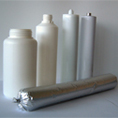Browse our products
The most choice and lower prices for all your glue job! Various equipments are available!
Contact us
Have a question? within 2 days, we will answer your questions.
Sealants
Sealants
Silicone is a polymer which is formed by a chain often described as inorganic binding: the chain consists of alternating silicon and oxygen atoms. The oxygen atom has no free bindings more, Silicon, however. To the silicon atom are organic substituents.Common substituents are:
• -CH3 methy
• l-ethyl-phenyl
• C6H5 C2H5 (benzene ring with one H less)
Applications
• Lubricant
• Silicon adhesive
• Silicone rubber Polydimethylsiloxane
• Silicone Putty to replace mastics
Applications of silicone adhesive include joints in sanitary fascilities, topsealing at glazing, seals in container spaces and cold rooms, seals in open air spaces.
Acrylic Adhesive
Acrylic adhesive is a glue that consists of esters of acrylic acid.The glue is made by polymerization of the esters.
No-mix-acrylic adhesive. No-mix (eng; not mixed) acrylic adhesive is a glue whose components separately on the substrates are made. After the substrates with the appropriate adhesive component in contact with each other, find the reaction site.
Application areas are:
Double-sided adhesive tape
Construction glue
Acrylsealant
Applications for Acryic sealants; seals joints and cracks in concrete and stone. Joints in masonry and plaster work. Add fill to window sill, door or window.
Sealing is so filling a crack or connection that there is an elastic connection arises. An exception to this rule is that a fixed mounting seal connects.
Glass panes in grooves are sealed, transitions from wood to stone are sealed, aquariums are be sealed, bathrooms, kitchen sheets, corners in tile work, small leaks in roofs, in short, the number of applications is endless.
There are many differentsealants all with their own characteristics, whether or not to be painted, or not suitable for humid spaces etc.
You must always realize that the dyeing of sealant could lead to problems. A sealant can often be a rack of absorbing as much as 25% without tearing. Paint, however, up to 1 a 2%. If the connection is going to work so very strong then chances are that the paint off jumps/tears in.
PU-adhesive
 PU-sealant(sealant) (Polyurethane) is a glue from the reaction of isocyanate with alcohol. The product of this reaction is a polyurethane foam.
PU-sealant(sealant) (Polyurethane) is a glue from the reaction of isocyanate with alcohol. The product of this reaction is a polyurethane foam.The glue connection is established by water (moisture in the air) which reacts (cross-linked) with the urethane compounds.
The adhesive surface of the air shut down (to thick glue or no breathable materials) then hardens the glue doesn't matter. The water (moisture in the air) can then no longer with the glue. To solve this problem is sometimes a hardener (booster) is added or a 2 k (two components) PU glue applied.
Application areas are:
• Construction adhesives (flexible and water-resistant) car windscreen bonding
• SMP-adhesive
SMP-lijm
SMP-glue (Silylation Modified Polymers, also called MS-polymer is a glue of modified silaan (SiH4) molecules. The glue connection is established by water (moisture in the air) which reacts (cross-linked) with the silane connections. For faster curing of the adhesive uses a 2 k (two components) SMP-glue.Application areas are:
• construction adhesives (in a moist environment)
• glassbondings
• dentistry
• sealants
Extra elastic kit
Extra elastic silicone acrylate kit containing a fungistatic processed. Use in all wet areas, bathrooms, toilets, pantry, kitchen.Available in transparent, white, grey, black, Jasmine (cream).
Acrylate is applied in:
All corners in tile work (corner joints in tile work in wet areas should never be added but must always be sealed off.
Connection bath-tile work
Toilet Bowl-floor connection
Counter top – tile work
Connection sink – Wall
Sanitary sealant can not be painted.
Sanitary sealant cannot be used for creating or repairing an aquarium, the mildew resistant resources are toxic to the fish.



